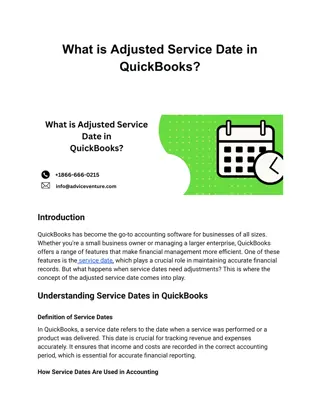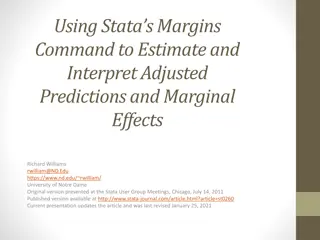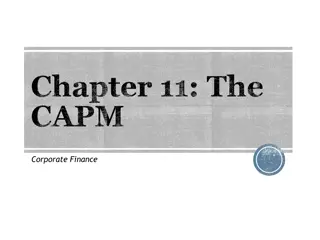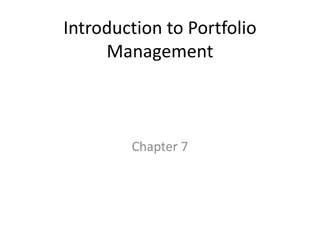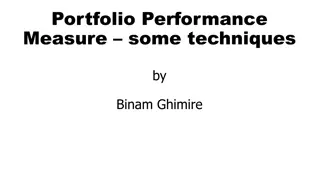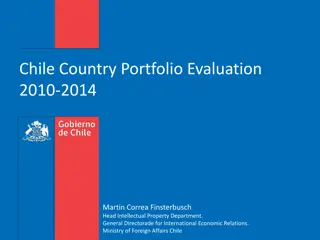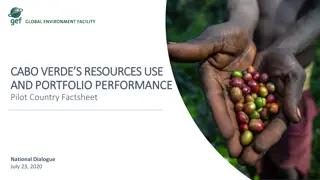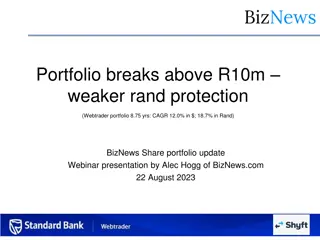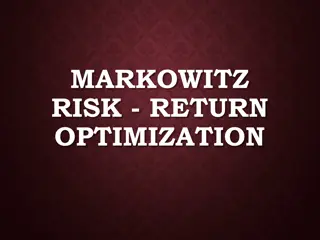Understanding Portfolio Evaluation, Management, and Risk-Adjusted Performance
Explore the world of portfolio evaluation by Dr. Pravin Agrawal, Ph.D. in Finance. Delve into the intricacies of portfolio management, balancing strengths and weaknesses in debt vs. equity, domestic vs. international investments, and more. Learn about measuring portfolio performance and risk-adjusted methods using modern portfolio theory. Discover popular measures like Sharpe's Ratio, Treynor's Measure, and Jensen's Differential Returns to assess return per unit of risk. Uncover the significance of risk-adjusted returns and Sharpe's Ratio in evaluating fund performance.
- Portfolio Evaluation
- Portfolio Management
- Risk-Adjusted Performance
- Modern Portfolio Theory
- Sharpes Ratio
Download Presentation

Please find below an Image/Link to download the presentation.
The content on the website is provided AS IS for your information and personal use only. It may not be sold, licensed, or shared on other websites without obtaining consent from the author. Download presentation by click this link. If you encounter any issues during the download, it is possible that the publisher has removed the file from their server.
E N D
Presentation Transcript
Portfolio Evaluation Portfolio Evaluation By Dr. Pravin Agrawal Ph.D. Finance
Portfolio Management Portfolio management is all about strengths, weaknesses, opportunities and threats in the choice of debt vs. equity, domestic vs. international, growth vs. safety, and numerous other trade-offs encountered in the attempt to maximize return at a given appetite for risk.
PORTFOLIO PERFORMANCE AND RISK ADJUSTED PORTFOLIO PERFORMANCE AND RISK ADJUSTED METHODS METHODS Modern Portfolio Theory provides a variety of measures to measure the return on a portfolio as well as the risk. When a portfolio carries a degree of risk, the return from it should be evaluated in terms of risk. More specifically, it is better to evaluate the performance of fund in terms of return per unit of risk. In case of a well-diversified Portfolio the standard deviation could be used as a measure of risk, but in case of individual assets and not-so- well diversified portfolios, the relevant measure of risk could be the systematic risk
PORTFOLIO PERFORMANCE AND RISK ADJUSTED PORTFOLIO PERFORMANCE AND RISK ADJUSTED METHODS METHODS There are three popular measures to estimate the return per unit of risk from a portfolio. They are: (A) Sharpe s Ratio (B) Treynor s Measure (C) Jensen s Differential Returns
Risk Risk- -adjusted Returns adjusted Returns The performance of a fund should be assessed in terms of return per unit of risk. The funds that provide the highest return per unit of risk would be considered the best performer. For well-diversified portfolios in all asset categories, the standard deviation is the relevant measure of risk. When evaluating individual stocks and not so well diversified portfolios, the relevant measure of risk is the systematic or market risk, which can be assessed using the beta co-efficient (b). Beta signifies the relationship between covariance (stock, market) and variance of market. Two well-known measures of risk-adjusted return are
Sharpes Ratio Sharpe s Ratio A ratio developed by Nobel laureate William F. Sharpe to measure risk-adjusted performance. It is calculated by subtracting the risk-free rate such as that of the 10- year US Treasury bond from the rate of return for a portfolio and dividing the result by the standard deviation of the portfolio returns.
Sharpes Ratio Sharpe s Ratio Sharpe index measures the risk premium of the portfolio relative to the total amount of risk in the portfolio. This risk premium is the difference between the portfolio s average rate of return and the riskless rate of return. The standard deviation of the portfolio indicates the risk. The index assigns the highest values to assets that have best risk-adjusted average rate of return
Sharpes Ratio Sharpe s Ratio The Sharpe ratio tells us whether the returns of a portfolio are due to smart investment decisions or a result of excess risk. This measurement is very useful because although one portfolio or fund can reap higher returns than its peers, it is only a good investment if those higher returns do not come with too much additional risk. The greater a portfolio s Sharpe ratio, the better its risk-adjusted performance will be
Example 1 Example 1 Consider two portfolios A and B. On the basis of information given below, compare the performance of portfolios A and B. Reward per unit of risk in case of Portfolio A is relatively higher. Hence its performance is said to be good
Example 2 The larger the S. better the fund has performed. Thus, A ranked as better fund because its index .457> .427 even though the portfolio B had a higher return of 13.47 per cent. The reason is that the fund B s managers took such a great risk to earn the higher returns and its risk adjusted return was not the most desirable. Sharpe index can be used to rank the desirability of funds or portfolios, but not the individual assets. The individual asset contains its diversifiable risk.
Treynor Treynor Portfolio Performance Measure Portfolio Performance Measure Jack Treynor in 1965 To understand the Treynor index, an investor should know the concept of characteristic line. The relationship between a given market return and the fund s return is given by the characteristic line. The fund s performance is measured in relation to the market performance. The ideal fund s return rises at a faster rate than the general market performance when the market is moving upwards and its rate of return declines slowly than the market return, in the decline. The ideal fund may place its fund in the treasury bills or short sell the stock during the decline and earn positive return. The relationship between the ideal fund s rate of return and the market s rate of return is given by the figure
Treynor Treynor Portfolio Performance Measure Portfolio Performance Measure The market return is given on the horizontal axis and the fund s rate of return on the vertical axis. When the market rate of return increases, the fund s rate of return increases more than proportional and vice-versa. In the figure the fund s rate of return is 20 per cent when the market s rate of return is 10 per cent, and when the market return is 10, the fund s return is 10 per cent. The relationship between the market return and fund s return is assumed to be linear.
Treynor Treynor Portfolio Performance Measure Portfolio Performance Measure With the help of the characteristic line Treynor measures the performance of the fund. The slope of the line is estimated by R p= a + Rm + ep Rp = Portfolio return Rm = The market return or index return ep = The error term a, = Co-efficients to be estimate Beta co-efficient is treated as a measure of undiversifiable systematic risk
Treynor Treynor Portfolio Performance Measure: Example Portfolio Performance Measure: Example Treynor s risk premium of the portfolio is the difference between the average return and the riskless rate of return. The risk premium depends on the systematic risk assumed in a portfolio.
Treynor Measure vs. Sharpe Measure The Sharpe measure evaluates the portfolio manager on the basis of both rate of return and diversification (as it considers total portfolio risk in the denominator). If we had a fully diversified portfolio, then both the Sharpe and Treynor measures will give us the same ranking.
Jensens Performance Index Jensen s Performance Index The absolute risk adjusted return measure was developed by Michael Jensen and commonly known as Jensen s measure. It is mentioned as a measure of absolute performance because a definite standard is set and against that the performance is measured. The standard is based on the manager s predictive ability. Successful prediction of security price would enable the manger to earn higher returns than the ordinary investor expects to earn in a given level of risk.
Jensens Performance Index: Formula Jensen s Performance Index: Formula The basic model of Jensen is given below Rp = average return of portfolio Rf = riskless rate of interest = the intercept = a measure of systematic risk R m = average market return Rp= + (Rm Rf )
Jensens Performance Index Jensen s Performance Index The return of the portfolio varies in the same proportion of Beta to the difference between the market return and riskless rate of interest. Beta is assumed to reflect the systematic risk. The fund s portfolio beta would be equal to one if it takes a portfolio of all market securities. The Beta would be greater than one if the fund s portfolio consists of securities that are riskier than a portfolio of all market securities. The figure shows the relationship between beta and fund s return
Jensens Performance Index Jensen s Performance Index Any professional manager would be expected to earn average portfolio return of R = Rf + 1 (Rm - Rf). If his predictive ability is superior, he should earn more than other funds at each level of risk. If the fund manager has consistently performed better than average Rp, there would be some constant factor that would make the actual return higher than average R. The constant may be that represents the forecasting ability of the manager. Then the equation becomes Rp Rf = p + (Rm Rf ) Or Rp = p + Rf + (Rm Rf )
Jensens Performance Index Jensen s Performance Index By estimating this equation with regression technique, Jensen claimed a the constant, reflected the professional management s ability to forecast the price movements. A comparative analysis of three hypothetical funds A, B and C are given in the figure
Jensens Performance Index Jensen s Performance Index Fund A s p is equal to the risk free rate of return. If no risk is undertaken, the portfolio is expected to earn at least Rf. It is hypothesized that it takes no particular professional managerial ability to increase the return Rp by increasing (Rm Rf). In the fund C, the manager s predictive ability has made him earn more than Rf. The fund manager would be consistently performing better than the fund A. At the same time if the profession management has not improved, it would result in a negative a. This is shown by the line B. Here the is even below the riskless rate of interest. Jensen in his study of 115 funds, he found out that only 39 funds possessed positive a and employing professional management has improved the expected return. On an average, fund s performance is worse than expected, without professional management and if any investor is to purchase fund s shares, he must be very selective in his evaluation of management. Thus, Jensen s evaluation of portfolio performance involves two steps.
Jensens Performance Index Jensen s Performance Index 1. Using the equation the expected return should be calculated. 2. With the help of Beta, Rm and Rf,, he has to compare the actual return with the expected return. If the actual return is greater than the expected return, then the portfolio is considered to be functioning in a better manner. The following table gives the portfolio return and the market return.
Among the risk adjusted performance and of the three portfolios, A is the best, B - the second best and the last is the C portfolio
Example Example Mr. X has owned units from three different mutual funds namely R, S, and T. The following particulars are available to him. He wants to dispose any one of the mutual fund for his personal expenditure. Which fund should he dispose?
References Security Analysis and Portfolio Management by Sudhindra Bhat, Excel Books Private Limited, New Delhi Investment and Portfolio Management by DR. R. Kasilingam




